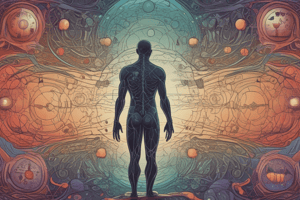Podcast
Questions and Answers
What are the components of a feedback mechanism?
What are the components of a feedback mechanism?
- Input, Processor, Output
- Sensor, Comparator, Effector (correct)
- Detector, Reference point, Balancer
- Receptor, Setpoint, Restorer
How is homeostasis achieved?
How is homeostasis achieved?
- Through rapid responses without any control
- Through regulation/controlling of the feedback mechanism (correct)
- Through random fluctuations
- By adjusting to external changes only
What is the main purpose of homeostasis?
What is the main purpose of homeostasis?
- To regulate sleep patterns
- To maintain a stable internal environment (correct)
- To respond to external stimuli
- To control voluntary movements
What is the role of the Effector in a feedback mechanism?
What is the role of the Effector in a feedback mechanism?
Why is it important to understand homeostatic regulation in relation to health, disease & illness, diagnosis & treatment?
Why is it important to understand homeostatic regulation in relation to health, disease & illness, diagnosis & treatment?
Which system is involved in the production of gametes (ova & sperm)?
Which system is involved in the production of gametes (ova & sperm)?
Which organ system is responsible for body temperature regulation?
Which organ system is responsible for body temperature regulation?
What organ serves as a vast reservoir of calcium in the body?
What organ serves as a vast reservoir of calcium in the body?
Which system is responsible for removing waste, fluid, and electrolyte balance?
Which system is responsible for removing waste, fluid, and electrolyte balance?
Which system is involved in appetite control and the reward system in humans?
Which system is involved in appetite control and the reward system in humans?
What are the two basic types of osseous tissue in the adult skeleton?
What are the two basic types of osseous tissue in the adult skeleton?
How are long bones typically shaped?
How are long bones typically shaped?
What is the subdivision of the skeleton that includes the bones of the limbs?
What is the subdivision of the skeleton that includes the bones of the limbs?
Describe the composition of spongy bone.
Describe the composition of spongy bone.
What are the four groups into which bones are classified according to shape?
What are the four groups into which bones are classified according to shape?
What are sesamoid bones, and what is their special characteristic?
What are sesamoid bones, and what is their special characteristic?
What is the structure of a long bone and what does it consist of?
What is the structure of a long bone and what does it consist of?
What is the role of articular cartilage in long bones?
What is the role of articular cartilage in long bones?
What is the function of epiphyseal plates in long bones?
What is the function of epiphyseal plates in long bones?
What is the primary function of the yellow marrow in adult bones?
What is the primary function of the yellow marrow in adult bones?
Where is red marrow primarily found in adult bones?
Where is red marrow primarily found in adult bones?
What do bone markings reveal about the structure of bones?
What do bone markings reveal about the structure of bones?
What are the two categories of bone markings?
What are the two categories of bone markings?
What is the function of Sharpey's fibers in long bones?
What is the function of Sharpey's fibers in long bones?
What is the composition of the epiphyseal line in adult bones?
What is the composition of the epiphyseal line in adult bones?
What is the function of the periosteum in long bones?
What is the function of the periosteum in long bones?
Flashcards are hidden until you start studying




